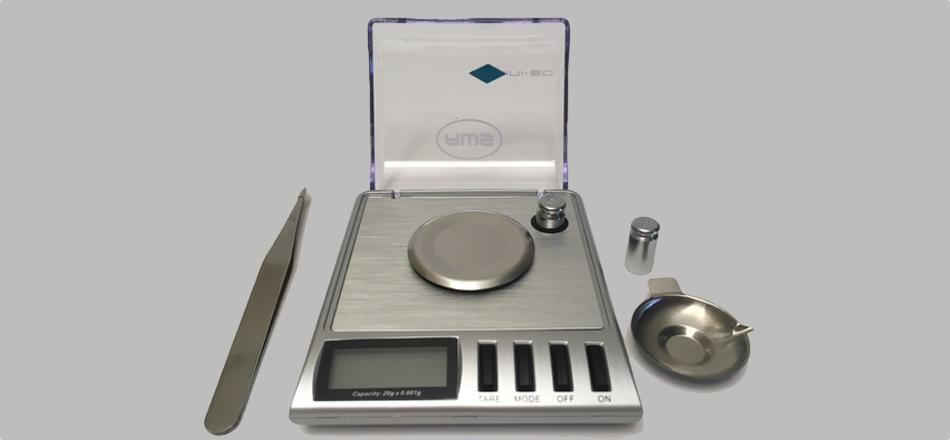Understanding the Limits of a Digital Scale's Accuracy

Any digital scale by necessity does some amount of rounding up or down of weights – while often a minor and insignificant issue, under certain circumstances it can have enormous significance for weighing drugs and tapering. Therefore, before implementing a taper using a digital scale, it’s essential to do some preliminary calculations to see if the planned taper might push against the limits of the digital scale’s accuracy.
- Determine the typical weight of the drug powder or beads that will be used during the taper.
- Based on the planned rate and schedule, calculate the size of the cuts for the planned taper. (See "Doing Calculations for a Taper".)
- Consult the digital scale’s technical guide to be certain of its readability and precision. The readability is the smallest amount of changes in weight that the scale is able to display and, as a general rule, the precision is half the readability.
- Determine if the weight of the drug and/or the weight of the planned cuts will come too close to the limits of the scale’s accuracy. Generally, measuring cuts that are less than ten times the scale’s readability could become very unreliable when trying to achieve tapering consistency. This becomes even more problematic as the initial starting weight of the drug comes closer to the lower limit of what the scale can measure.
Discussion: Consider a scale that weighs up to a maximum of 100g, has a readability of 0.001g or 1mg, and precision of half that, or 0.5mg. This means that when the scale reads 0.001g or reads a change that is only 1mg in size, such as a cut that lowers the weight from 0.069mg to 0.068mg, the scale is actually rounding up or rounding down. So when the scale reads 0.002g, the actual weight could be as high as 0.0024g or as low as 0.0015g, or anywhere from 2.4mg to 1.5mg. While the difference between 50.0024g and 50.0015g may not be significant, this same difference can become very significant during drug tapering that involves weighing amounts that are close to the lower end of what the scale can measure: A 20mg weight of powder could actually be as much as 20.4mg or as little as 19.5mg – which is already about a 5% difference in possible drug amounts before even making a cut. Even more seriously, while aiming for 2mg in weight of drug powder, a person could end up taking exactly 2mg one day, then 1.5mg the next day and 2.4mg the next day – so in effect the person will on the first day be taking their intended dose, then unknowingly decreasing that drug dose by 25% the next day, then unknowingly increasing that dose by 60% the next day, and so on. (For more information about using digital scales and calculating error rates and levels of accuracy, this article on mixing concrete and pigments is instructive.)
Layperson tips if a taper plan pushes against the limits of a digital scale’s accuracy
- Use a Cut-and-hold schedule instead of a Daily Microtaper to reduce the necessity of trying to achieve extremely tiny variations in cuts.
- Consider if the significance of the scale’s errors could be lessened by working with multiple tablets or capsules at once, thereby increasing the overall base weight on the scale.
- Use a pharmaceutical-grade powder filler to increase the base weight of the drug and thereby reduce the significance of the scale’s error rate. (See instructions here.)
- Caution: Some people have anecdotally reported increasing the base weight they’re measuring by adding a coin or other known weight to the scale alongside the drug – but while this may make the scale’s display readings appear more consistent, in fact this typically does not actually improve the ability of a scale to accurately measure these relatively tiny weights or weight changes in the amount of drug itself.
In this section
- Step 10- Get Informed About Your Psychiatric Drug
- Step 11- Ensuring that a Drug is Relatively ‘Taper-friendly’
- Step 12- Interactions, Reactions and Sensitivities
- Step 13- Taper Rates
- Step 14- Taper Schedules
- Step 15- Taper Methods
- Step 16- Preparatory Decisions
- Step 17- Gather the Gear
-
Step 18- Essential Skills
- Counting and Making Cuts with Beads
- Diluting Powder When Using a Digital Scale
- Understanding the Limits of a Digital Scale's Accuracy
- Using an Adapter Cap
- Using a Digital Scale for Weighing and Making Cuts
- Using a Mortar and Pestle for Pulverizing Tablets
- Using Syringes
- Doing Calculations for a Taper
- Special Tips for Calculations and Liquids
- Step 19- Setting Up a Taper Journal
- Step 20- Implementing a Taper
TWP’s Companion Guide to Psychiatric Drug Withdrawal Part 2: Taper